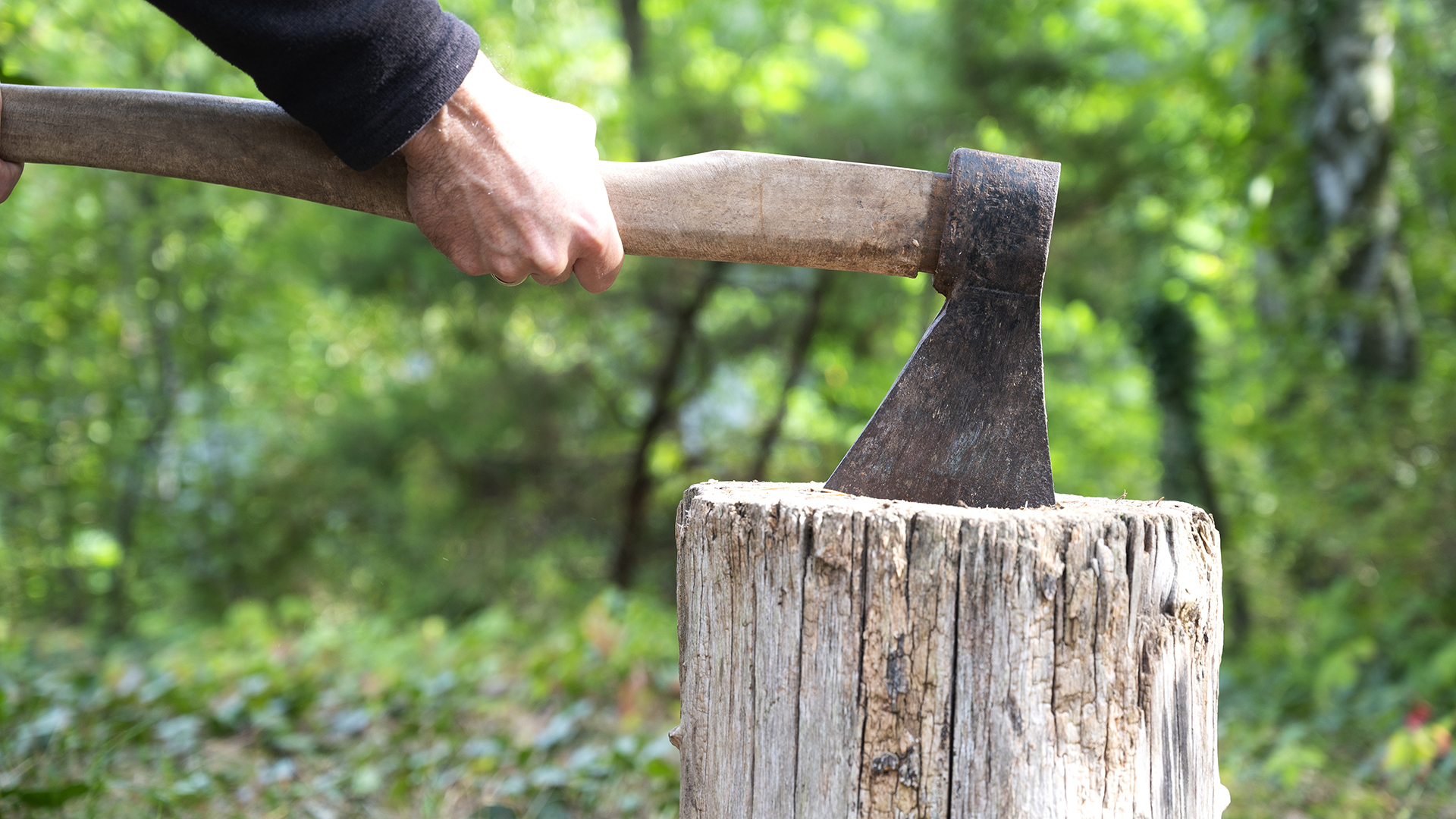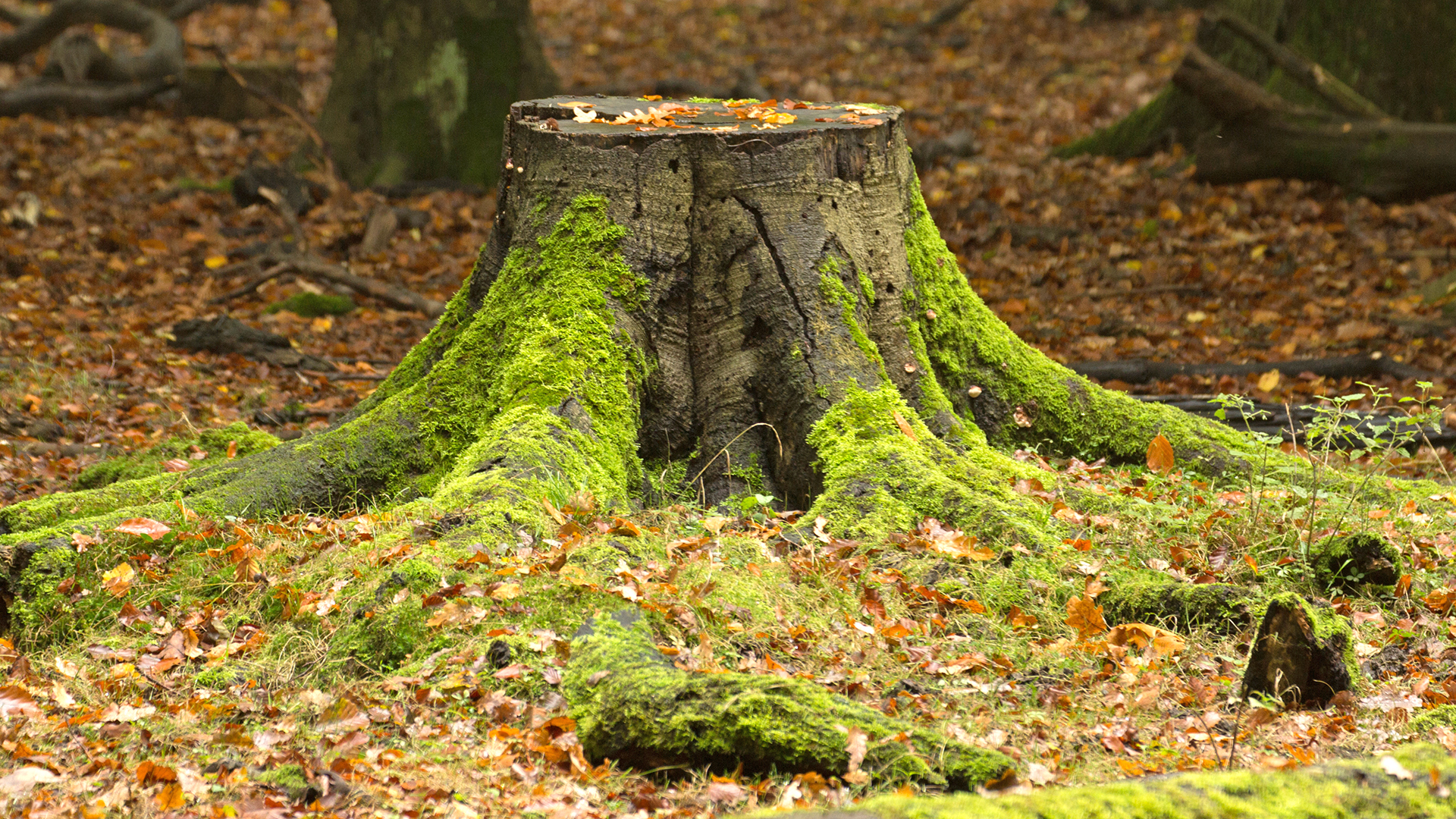How to remove a tree stump
Learn how to remove a tree stump on a DIY basis – and when to call in the professionals


When deciding how to remove a tree stump, you will need to consider its size, your budget, and how much time you are prepared to invest, as there are several ways to get the job done.
A tree stump is an inevitable consequence of cutting down a mature tree, but it doesn’t have to be a blight on your backyard ideas. There are some really creative tree stump ideas to turn it into a practical and even beautiful feature.
However, if you do choose remove a tree stump, then it's important to establish whether you can tackle it on a DIY basis, or if you need to bring in a professional.
How to remove a tree stump

‘Removing a tree stump can be challenging due to its weight and size. When a stump is too big or problematically located – for example on a sloping piece of land – it will need professional assistance,’ says Lisa Tadewaldt, arborist and owner of Urban Forest Pro.
‘The average homeowner will struggle to address a large stump without renting tools, and you also need to factor in disposal, which is often limited at your run-of-the-mill green waste drop-offs.’
However, if you are dealing with a smaller tree stump, have time on your hands, or are willing to rent tools, then there are several DIY options worth exploring.
How to remove a tree stump by hand
As long as the tree stump isn’t too big, it should be possible to remove it by hand. This involves digging it out of the ground using the the tools you have at home.
Design expertise in your inbox – from inspiring decorating ideas and beautiful celebrity homes to practical gardening advice and shopping round-ups.
It’s definitely worth taking this approach if you want to save your tree stump, and recycle it for a woodworking project. ‘High-quality tree stumps can be upcycled to furniture and different DIY projects,’ says Robert Johnson, woodworker and founder of Sawinery.
‘Instead of it going to waste, I would suggest removing it by hand, as other methods such as burning, grinding or decaying will destroy it.’
Using hand tools will enable you to keep the stump as intact as possible. However, bear in mind this method takes a considerable amount of time and effort.
- To remove a tree stump by hand, you need to dig out the entire area around the stump using a shovel, pick mattock and/or digging bar. ‘Keep digging until you expose as many roots as possible,’ says Ray Brosnan, landscaper at Brosnan Property Solutions.
- Next, cut through the larger roots using an axe, loppers or root saw. You can use a chainsaw if you have one.
- ‘As you work your way through the roots, you may come across smaller ones, which can be severed with clippers,’ adds Brosnan.
- Pull out the roots. ‘A grub hoe will do the job of wrenching the remaining entrenched roots out of the ground to their very tips,’ says Johnson. ‘You can make more cuts as necessary to make pulling them out of the ground easier.’
- Now you can begin to remove the stump from the soil. ‘Without most of the roots, you should be able to easily dislodge the stump,’ says Johnson. ‘You may need to use a shovel to dig underneath the stump and cut a few more roots under it before you can get it out.’
- Finally, cover the hole with surrounding soil, and add mulch and topsoil.
Removing a tree stump by hand is not without its issues, however: 'As well as taking a serious amount of work, it can potentially be destructive to your yard,' says Brosnans.
'If in doubt of how to remove a tree stump without causing damage, leave it to a professional who will have the adequate tools for the job.’
How to use a stump grinder to remove a tree stump
Using a stump grinder is a popular way to remove a tree stump, and can be performed using rented machinery. Alternatively, you could hire a professional to do the job for you.
‘Using an appropriate size of tree stump grinder, you can remove the stump quickly, and in a way that is safe for you and the environment,’ says Codey Stout, head of operations for TreeTriage.
Tree stump grinders are substantial pieces of machinery, and can cost upwards of $200 per day to rent. They are maneuverable on wheels and use very sharp blades to grind the stump and roots down, up to several inches below ground.
Do not attempt to grind a tree stump in bad weather, and make sure you have good work boots, gloves, clothing and face protection.
- First, ensure the working area is safe. ‘Clear the area around the stump so you can move around easily – remove foliage, rocks, and other debris or tripping hazards,’ says Stout.
- Use a spade to dig around and make sure there are no rocks hiding beneath the surface, as they can damage grinder blades.
- Before using a grinder, it may first be necessary to use a chainsaw to cut the stump as short as possible, as this will make grinding easier. However, you should not attempt to cut the stump level to the ground, as this can be dangerous.
- Make sure you have read and understand the operating instructions supplied with the grinder.
- Move the grinder next to the tree stump before starting the engine. Stay at the handle end at all times.
- You will need to lever the machine up on the stump, going inwards by a couple of inches. Then simply move it side to side. ‘Don’t apply force – let the machine do the work until the stump has been ground out below the ground level,’ says Stout. Aim to dig down around 4-6 inches.
- Dig up and remove any remaining roots.
- ‘Once the stump and roots have been removed, cover and treat the area by raking the resulting wood chips into the hole and covering it with a few inches of mulch and topsoil,’ says John Lucas, owner of J&L Landscaping.
Using a stump grinder to remove a tree stump is quicker than the alternative removal methods, but it does take time, so find a clear day to do the work. ‘The whole job can take several hours depending on the size of the stump,’ says Lucas.
How to remove small tree stumps
Small tree stumps should be fairly easy to remove on a DIY basis. ‘If the tree stump is reasonably small, you can remove it by cutting sections of the roots and pulling it up – you could use a truck to help you,' says Lucas.
'You can even take it out by hand with some basic tools like a saw, shovel, and sledgehammer.'
For smaller tree stumps, you usually won’t need to remove the entire stump and root system. ‘By simply cutting a few inches below the grass line, you can remove the stump and re-lay the turf on top,’ adds Lucas.
‘If done correctly it would be difficult to even realise that a tree has even been there and the root system will slowly rot underground over the next few years.’

How to rot a tree stump
Given enough time, a tree stump will eventually rot and break down, but this can take a number of years.
‘To accelerate this, you can add chemicals to the stump to allow it to break down more quickly,’ says Tadewaldt. ‘It won't just disappear but it will become more manageable to break down and remove. It beats waiting up to a decade!
'Environmental laws vary, so you'll need to check what chemicals are allowed in your area. However, you can use high nitrogen-based fertilizers.' Alternatively, use a branded tree stump-killer product.
You need to tackle this job in dry weather, so the chemicals have chance to work properly.
- Begin by drilling multiple holes into the top of the tree stump and more along the sides at a downward angle.
- Fill the holes with your chosen stump removal product.
- Lightly wet the stump and soak the soil around it, then cover it with a tarp to trap the moisture. 'Cover the tarp with organic-matter mulch, such as hay or bark,' says Tadewaldt.
- 'If you live in an area prone to gusty winds, place some pavers or large rocks on the corners of the tarp to ensure your concoction underneath stays in place.'
- You should notice the treatment taking effect within a few months, but it can take up to a year. 'You'll know it's working when the tree stump feels softer and more spongey,' adds Tadewaldt. At this point it should be easy to remove.
Bear in mind that there is always an environmental impact when using chemicals in the garden. ‘Stump killer is not always a preferable go-to,' says Warren Byington from landscaping firm Backyard Brothers.
'The chemical agent will likely seep into the ground, drip, or risk spillage or too much product being used, and this puts surrounding plants' and trees' health at risk.’
‘Additionally, people can endanger themselves with chemical stump-removing formulas. So make sure no garden or crop is too close and that it's an area where children don't play.’
How to remove a tree stump with Epsom salt
When researching how to remove a tree stump, you may have heard of epsom salt or rock salt being recommended.
This is a widely available, low-cost solution if you aren’t in a hurry, and the process is similar to rotting the stump.
- As when rotting a tree stump with chemicals, you need to drill multiple holes into the top of the stump.
- Pour the Epsom salt or rock salt into the holes, filling them right to the top.
- Add water to moisten the salt, but don’t pour it so fast that the salt overflows.
- Cover the stump with a tarp or plastic bag.
- Check the stump every 3-4 weeks and repeat the process until the stump dies.
How long does Epsom salt take to kill a stump?
How long Epsom salt takes to kill a stump depends on the size and tree type, but you can expect it to take effect within six months. A large stump could take as long as a year to break down.

How to burn a tree stump
Another method of removing a tree stump is to burn it, which requires less man power than digging it out, and is also a lot faster than rotting it.
However, this method is only suitable where the stump is not located close to buildings, trees or plants.
'The process can take up to two weeks of burning the stump daily,' says Stout. 'Before proceeding, you need to check if burning a tree stump is legal in your area based on local ordinances.'
- Before you burn a tree stump, you need to cut it as close to the ground as possible. A chainsaw is the best tool for this job, but do not attempt to level it to the ground.
- 'Drill several holes down into the stump, as well as from the side, to allow enough oxygen to feed the fire,' says Lucas.
- 'Apply a small amount of kerosene (never use gasoline/petrol) into the holes and carefully light.'
- 'This will burn over a day or two and leave behind a hole full of ash which can be easily swept away when fully cooled,' adds Lucas.
- Finish by treating the area with a good amount of mulch and topsoil.
What is the fastest way to remove a tree stump?
The fastest way to remove a tree stump is to use a tree stump grinder, which usually takes a few hours to completely grind it down.
Tree stump removal cost
‘Removing a tree stump costs around $450 on average and can be as expensive as $800,' says Hank Martin, CEO of Tree Musketeers. 'It's a separate process from a basic tree removal service, and the cost will depend on the size, type, location, roots, and condition of the soil.'
Meanwhile, Tadewaldt advises that you should expect to pay a minimum of $200 for the job, so it's worth getting more than one quote.
‘However, you can rent all the tools from local vendors for around $300 per day if you want to handle it 100 per cent DIY.’

Issues with removing tree stumps
Whatever tree stump removal route you take, you should check for any wildlife before starting work.
'Be cognizant of what can lurk around – or in – stumps,' says Byington. 'I recently encountered a formidable population of brown recluse spiders within a large old stump and was grateful to have shone my flashlight and analyzed the area thoroughly.
'Venomous spiders such as recluses and black widows love wood, especially dark, dank wood. From spiders and snakes to rabbits and mice, a variety of creatures regard stumps as home!'

Melanie has worked in homes and gardens media for two decades. Having previously served as Editor on Period Living magazine, and worked on Homes & Gardens, Gardening Etc, Real Homes, and Homebuilding & Renovating, she is now focusing on her passion for gardening as a Senior Editor at Gardening Know How. As a keen home grower, Melanie has experimented with pretty much every type of vegetable at some point – with mixed results. Often it is the simplest things that elude you, which may explain why she just can't seem to master zucchinis.